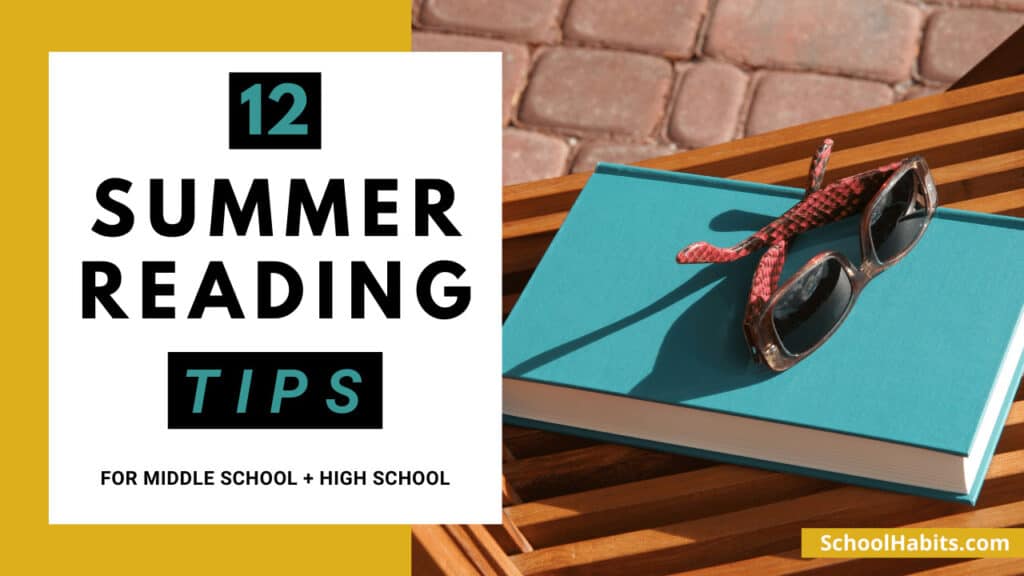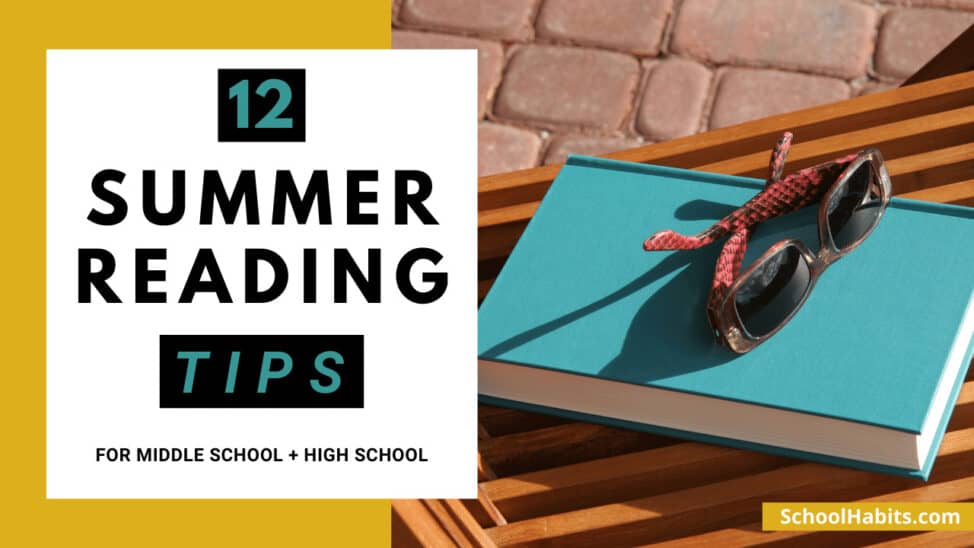By Katie Azevedo, M.Ed.

Required summer reading often involves the same challenging books as school-year reading, but without all the teacher support and guidance along the way. For this reason, some middle and high school students who succeed with school-year reading will struggle to independently manage summer reading.
The following 12 summer reading tips for middle school and high school students are intended to support students’ summer reading efforts similar to how their teachers would support those efforts during the school year. Most middle school and high school students, especially those with reading-based disabilities or ADHD, will benefit from implementing as many of the following 12 summer reading tips as possible.
Summer reading tips for middle school and high school students
1. Make a summer reading schedule and stick to it.
To do this, you need basic math skills and a calendar. Here’s exactly how. (Bonus: Free printable summer reading schedule included – it’s the same one I use with my 1:1 clients, so it’s a good one.)
2. Create a reading routine.
Instead of picking up your book whenever you feel like it, aim to read at the same time each day (before bed?) in the same location (in bed? in your favorite chair?). Routine = habits = getting it done.
3. Prime yourself before reading.
Priming is a legitimate learning strategy and it works. Research the book, author, topic, time period, etc. before reading your book so that you have some basic knowledge to work from as you read. The more background information you know before you read, the more you will comprehend and remember from the book.
4. Write chapter summaries after finishing each chapter.
A few bullet points are fine; summary points should be simple and plot-based. You can write these directly on the first page of each chapter, use sticky notes, or write them in a separate notebook. I suggest using a sticky note on the first page of each chapter. Here’s exactly how to write chapter summaries. Here’s my quick video in which I explain exactly how to write perfect chapter summaries.
5. Use the highlight and rewrite strategy as you read.
Here’s how. Remember, a good annotation strategy should always involve writing something; only highlighting text without indicating why you highlighted it is incorrect. Be sure to avoid these 6 common annotation mistakes.
6. Keep a running character list.
This can be simple, like a bookmark-size piece of paper to which you add characters and character traits as you read.
7. Look out for symbols and motifs.
Before reading, Google if there are any important symbols or motifs in the book. As you read, circle all references to these symbols.
8. Read for themes.
Almost every book on a school-generated summer reading list contains one or more themes. (Because … school.) Identify the main themes as your read (or Google them beforehand!) and track them in the book. Track them = annotate / underline them.
9. Talk about the book whenever you can.
Here’s a fact: the more we teach something, the more we understand it. So the more you talk to others about the book you’re reading, the more you’ll understand and remember it. Can this be cheesy? Yep. Do it anyway.
10. Listen to the audiobook while reading it.
Only in rare cases do I recommend listening to the audiobook without following along in the actual book (for so many reasons). But on the other hand, I approve of using audiobooks to supplement the reading process as long as you have the book in front of you, follow along with the audio, and pause to take notes.
11. Keep your notes organized.
If you’ll have to return your library book before school starts, make sure you take notes in a central location like a notebook. If you’re using sticky notes in the book, pull them off the pages and stick them to 8.5 x 11 sheets of paper (with page numbers) before returning the book. Here are 7 ways to keep your notes organized.
12. Use online Teacher’s Guides to check your comprehension.
For most popular books, you can find free online resources designed for teachers. These guides often contain reading comprehension questions that you should use to guide your understanding. If you can’t answer the questions in the guides, your comprehension is off.
Final notes about summer reading tips for middle school and high school students
It’s important to remember that the purpose of required summer reading is not plow through a book just to say “I did it.” The purpose is to read a book(s) well enough that you understand it and remember it well enough to talk or write about it when you return to school in the fall. If you hastily fly through a book in July and forget it by September, you’ve missed the point. Many of the tips above are rooted in actual learning strategies that increase comprehension and retention, and that’s why they work.
- Are you a parent with a reluctant reader? Here are 3 ways to encourage your child to read.
- Are you confused about how to annotate (take notes)? Here are all my annotation resources and guides.
- Are you feeling overwhelmed with completing you AP summer coursework before school begins? Here are the 3 simple steps for completing AP summer coursework without the stress.

